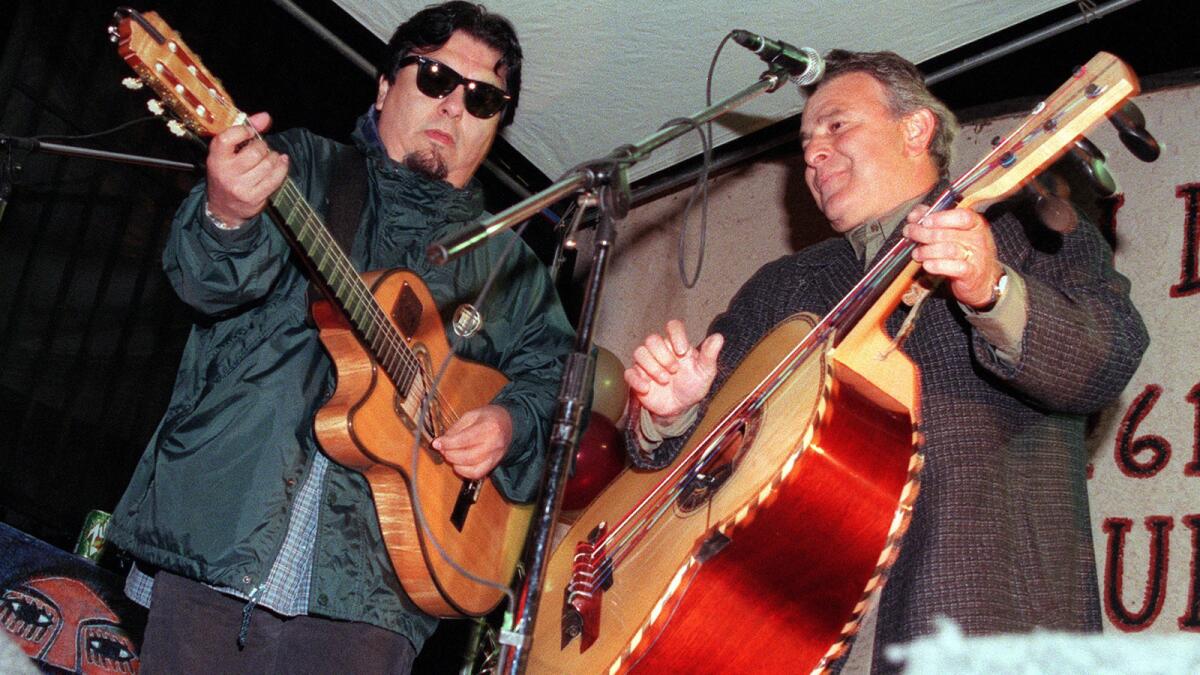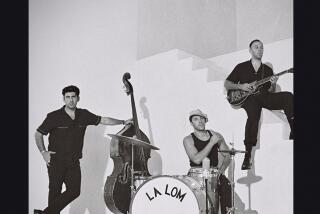From the Archives: Los Lobos and commercial success: Blame it on ‘La Bamba’

Ceasar Rosas and Conrad Lozano of Los Lobos playing on Feb. 6, 1999.
In recording its “The Neighborhood” album, Los Lobos wrestled with questions of artistic purity and commercial compromise. This story was originally published on Sept. 2, 1990.
“THERE’S NO SUCCESS LIKE FAILURE and failure’s no success at all,” Bob Dylan wrote more than 25 years ago, capturing the ironic nature of these powerful but unpredictable forces. Depending on how they are handled, success can often lead to failure, and failure can spur one on to success.
One reason Los Lobos has taken so long to record the true follow-up to its 1987 album, “By the Light of the Moon,” is that the East Los Angeles-spawned quintet has been dealing with questions of success and possible failure. At stake: the group’s artistic purpose.
“Moon” was a dark, moving series of tales about the troubled pursuit of the American Dream, seen inescapably through a barrio perspective.
Arguably the most culturally arresting and musically embracing work by a Los Angeles-based group in nearly a decade, the graceful, warm-spirited collection sold a respectable 400,000 copies and was named to the year-end Top 10 lists of numerous critics.
Yet “Moon” was almost totally eclipsed in the public mind by the runaway success a few months later of Los Lobos’ next recording venture: four songs for the soundtrack of “La Bamba,” the film biography of ‘50s Los Angeles Latino rock star Ritchie Valens. The album sold more than 2 million copies and Los Lobos’ title track spent 3 weeks at No. 1 on the pop charts.
The natural thing from a commercial standpoint would have been for Los Lobos to return with another collection of good-time oldies. But that would have meant setting aside the compelling vision that made “Moon” and the earlier “How Will the Wolf Survive?” recordings so memorable.
SIGN UP for the free Essential Arts & Culture newsletter >>
Instead, the quintet released “La Pistola y El Corazon,” an album of Mexican folk music. The album sold about 100,000 copies--impressive for such a daring venture, but negligible when compared to the “La Bamba” success.
Louie Perez and David Hidalgo, the group’s primary songwriters, now admit that Los Lobos was, in some ways, buying time with the “La Pistola” album.
“The only sad part of the ‘Moon’ album (experience) was that it was overshadowed by ‘La Bamba,’ ” said Hidalgo, who also sings lead on most Los Lobos tunes. He was sitting with Perez on the porch of Perez’s old family house in East Los Angeles.
“It was nice to see the crowds start getting bigger at the shows, but we would wonder sometimes why these people were in the theater. Was it to see us or just because of the movie? So, in a way we were removed from some of that success.”
The “Pistola” project, he added, was designed to salute the Mexican folk music that the group played for years at weddings and dances in East Los Angeles before moving over to rock in the early ‘80s.
Perez, who plays drums and writes most of the band’s lyrics, said “Pistola” gave them a way to “dig back, get back to us again . . . help us get on the right track to write this new album.”
The band’s new album, “The Neighborhood,” features a few bluesy, high-spirited workouts that should appeal to “La Bamba” fans, but mainly the album--which will be released Tuesday--radiates with the disarming artistic vision exhibited in “By the Light of the Moon.” (See adjoining review).
It wasn’t always easy.
Los Lobos--which will be in concert Oct. 18 at the Starlight Bowl in San Diego and Oct. 19 at the Greek Theatre in Los Angeles--began work on the new album in late 1988, expecting to finish in time for release last January. But writing it took longer than expected. One reason: “La Bamba’s” success.
“It felt great when (Warner Bros. Records president) Lenny Waronker told us, ‘Don’t worry about the ‘La Bamba’ thing. . . . Get back to what you guys are about,’ ” said Perez, who tends to speak more during interviews than Hidalgo.
“And it’s not that we ever thought of trying to make ‘La Bamba II.’ That would have been ridiculous. But there’s no doubt that during the course of writing the songs for this album there was this thing looming over you . . . the thought that you have to live up to the commercial success that we had with ‘La Bamba.’ ”
Perez paused--as if trying to find the right words to describe the psychological currents at work in the band as they made the new album.
“I think we told ourselves a few times that maybe we shouldn’t be as dark and as introspective as ‘Moon.’ ... That maybe we should do something more accessible,” he said.
“But every time we started going too far in that direction, we found ourselves stopping and clearing the table ... starting all over, getting back to something that really meant something to us.
When Perez, 37, talks about his neighborhood, on the porch of the small, one-bedroom house that his grandparents passed on to his dad when his parents got married, he is also talking about his music.
“It’s a funny place, kind of in the middle of nowhere,” he said of the neighborhood near the intersection of Brooklyn and Eastern avenues. “It has always been that way as far as the gangs were concerned. They kind of left this area alone because it was like nobody’s territory.
“One (gang’s) territory begins over there around Eastern and there’s another that starts at the top of the hill and another when you cross Brooklyn.
“It was never a completely peaceful place, but it was this little island when I was growing up. It’s starting to deteriorate now. Things are starting to creep up on it a little bit. About the only thing that is left here is a lot of memories.”
Many of those memories are musical.
“There was always music at the house,” Perez said, while his mother prepared chiles rellenos for him and Hidalgo in the kitchen. “My mom was really into music. When I was about 8 or 9, she used to drag my sister and myself to downtown L.A. to these Mexican variety shows.”
The four original members of Los Lobos (saxophonist Steve Berlin joined the group in the ‘80s) were friends at Garfield High School, but were in separate rock bands until getting together in the early ‘70s. Disillusioned by only being able to play Top 40 hits at clubs and dances with their bands, the four friends began exploring acoustic Mexican music in their off hours at the Perez house.
They enjoyed it so much--and found such a positive reaction to it--that they switched styles, playing hundreds of weddings and dances between 1974 and 1980.
Eventually, however, Los Lobos got caught up in the energy and imagination that was being generated by such rock bands as X and the Blasters on the Hollywood club circuit, and the group shifted to rock.
There were other bands on the scene with a Latino connection, including the Plugz and Los Illegals, but none offered the originality and imagination of Los Lobos’ cross-cultural vision.
“A lot of people warned us that we’d never be accepted in the Hollywood rock clubs,” Hidalgo said. “And other people used to tell us how they liked our music better before we started playing the Hollywood clubs.”
“We didn’t buy it,” Perez said. “The idea that there were boundaries or limitations because we were from East Los Angeles or there might be some racial problem,” he said. “It’s real easy for people to just kind of put themselves into this psychological gridlock. . . . Like, ‘You’re stuck here and there is nothing you can do about it.’ ”
The early shows had the relaxed, good-natured feel of a neighborhood block party. But gradually, an undercurrent of social commentary began to surface and the group stepped up to an entire new creative level.
A turning point was 1984’s “Will the Wolf Survive?,” a song of hope from the group’s second Slash album.
Sample lyrics:
All alone in a world that’s changed
Running scared now forced to hide
In a land where he once stood with pride
But he’ll find his way by the morning light
Encouraged by the strong response to “Wolf,” Perez and Hidalgo began concentrating more fully on social themes in the stirring “By the Light of the Moon” album.
Though part of the power of the music was in its reflection of a barrio experience, the songs were written with a universality that made them odes to people anywhere who cling to their ideals and faith in the face of handicaps and social adversity.
The memories at Perez’s house aren’t all musical.
Before heading inside for lunch, Perez saw two youngsters walking down the street, pulling a wagon, and remembered his own childhood.
“There are some things you learn real quickly as a little kid riding your bike . . . like where you can go without running into gangs or trouble. . . . But there are other things that take you years to figure out,” he said.
“Like, I could never understand why all those women were in the building around the corner. . . . 150 sewing machines in there. It was a sweatshop. It just didn’t seem right, but you didn’t know why. Those are some of the things we explore now in our music.”
In fact, Perez and Hidalgo used the image of a sweatshop worker in “One Time, One Night,” on the last album, and there are other images of the neighborhood in some of the songs on the new album.
“We didn’t set out to call the album ‘The Neighborhood,’ ” Perez said. “It (the title song) was one of the last songs we wrote for the album and it seemed to tie things together.
“It’s a song about urban decay and drugs and everything. . . . About the way each person in a family is affected by the pressures of the inner city.”
Perez lives with his wife and three sons (ages 14, 5 and 1) about 15 minutes away in Whittier, and he’s planning to move his mother closer to him. (Hidalgo also lives in Whittier, while Rosas lives in Rowland Heights, Lozano lives in Walnut and Berlin makes his home near Seattle.) Most of her old friends in the neighborhood have either moved or died, and the bars on the windows underscore his concern about increased crime in the area. Meanwhile, he stops by often to say hello or have lunch.
Despite the darkness in the song “The Neighborhood,” there is also an ultimate sense of optimism--a faith in the resilience of people:
Like the smallest rose
Out of the hardest ground
Like a tiny hand
Reaching up for the sun ...
Let’s hope our hearts are one.
“You can’t get away from the usual news of gang violence and drive-bys and everything else, but there’s no reason to lose hope,” Perez said. “And that’s what we do in our music. We try to be constructive, give people some of that hope.”
Perez paused once more, digging deeper into the band’s philosophy and past.
“We had to make a decision a long time ago . . . whether to just be a good sock hop band or something more,” he said. “And I think the answer to that question had a lot to do with where we came from. . . . This neighborhood.”
More to Read
The biggest entertainment stories
Get our big stories about Hollywood, film, television, music, arts, culture and more right in your inbox as soon as they publish.
You may occasionally receive promotional content from the Los Angeles Times.










